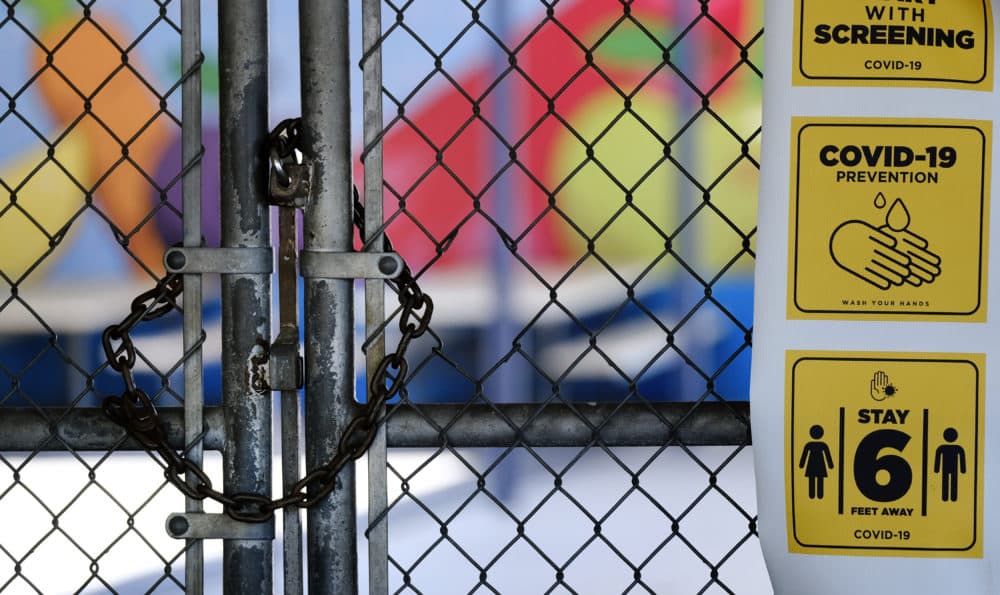Advertisement
Coronavirus Coverage
What The Research Says On Opening Schools In Massachusetts This Fall
Resume
As schools around Massachusetts look to bring students back into the classroom this fall, education and public health leaders are looking to the latest research to guide reopening safely. But experts say that the science on how easily COVID-19 can spread in schools is still very uncertain.
“There’s a lot of confusion around this,” says William Hanage, an epidemiologist at Harvard University. “We don’t actually know how much transmission happens in schools because we haven’t had the opportunity to investigate any of them in sufficient depth.”
Much of the research that is out there suggests that schools don’t tend to be hotspots for coronavirus transmission, but Hanage says that’s complicated by the fact that for the most part, schools haven’t been open.
Also, young people tend to have only mild or asymptomatic cases of coronavirus, making it harder to notice cases among students. Because that’s especially true for young children, Hanage says it’s difficult to trust data that suggest young children might not be able to transmit the virus as easily as adolescents or adults.
If anything is for sure, Hanage says, it’s that opening schools will spread the coronavirus, but opening can still happen safely so long as the transmission rate in the overall community is low enough.
“Schools will provide some contribution to [COVID-19] transmission, you can’t avoid that,” says William Hanage, an epidemiologist at the Harvard T.H. Chan School of Public Health. “It’s obviously the case that it is safe for schools to reopen when community transmission is low.”
Here are a few takeaways from the medical literature on schools and COVID-19:
Managing COVID-19 in classrooms hinges on the precautions taken in schools and in the community.
School district and state guidelines in Massachusetts for opening classrooms all recommend basic COVID-19 precautions, like mask wearing and physical distancing. That will be crucial to keeping any coronavirus transmission down in the schools, Hanage says. Tactics like creating dedicated quarantine spaces for students or staff who become sick at school, improved ventilation and continued testing for students will help.
That doesn’t necessarily mean it will be easy, though. Even if classes are a mix of in-person and online, schools will need to make social distancing feasible on buses and in the buildings themselves. For schools with larger classes or limited extra space, that may be a challenge.
It’s equally important for the overall community to continue following COVID-19 precautions if schools are to stay open, Hanage adds.
“You should think about it in terms of a sort of transmission budget. There’s a certain amount of cases that you are accepting within your community,” he says. “You want to keep it low enough that schools can be open, but they will increase transmission. But if you can make up for that elsewhere, it will help them stay open longer.”
Policies will need to keep equity in mind.
The COVID-19 pandemic has already fallen harder on low-income and racial minorities, and it’s going to be more difficult for school districts with fewer resources to provide supports like health professionals when needed. Before the pandemic started, some schools didn’t have full-time nurses on site, and bringing on more health professionals will cost money, as will providing protective gear for teachers and staff.
“We really have to be mindful of the ways in which we are going to distribute resources, specifically with regard to testing,” says Nadia Abuelezam, an infectious disease researcher at Boston College. “If we don’t, I think we’re just going to see increases in the disparities that students, faculty and staff of color will be facing come the fall.”
Without that careful attention to equity, Abuelezam says educational disparities might also be exacerbated by the pandemic. For instance, if school districts don’t provide coronavirus testing, it will be up to the students to show a negative test to return to class after having symptoms. Students without insurance or access to a testing center may end up missing out on more learning as a result.
Massachusetts is currently well positioned for opening schools in the fall.
Because the state has enjoyed a low positive test rate for the coronavirus for months without any significant increases, experts are optimistic about its ability to open schools this fall. Massachusetts has done very well in continuing to follow COVID-19 precautions, Hanage says. While there’s been a slight uptick in cases in recent weeks, numbers have started to fall back down and stabilize in some places like Boston.
“I think we’re among the best places in the country where schools can open,” Hanage says. “This all depends, but I think that if you have amounts of disease consistently as low as they have been around [Massachusetts], then I think that schools can open.”
But the situation can always change, Hanage says. If the state experiences another large surge in COVID-19 cases, then school districts will need re-evaluate.
“The pandemic may not play along,” he says. “If community transmission reaches the point where you are having multiple, separate introductions to a school followed by outbreaks, it’s really hard to see how a school can remain open.”
This article was originally published on July 30, 2020.
This segment aired on July 30, 2020.
